
Overview of Forklifts
Definition: A forklift is a powered industrial truck used to lift and move materials over short distances. They are essential in warehouses, construction sites, and manufacturing facilities.
Types of Forklifts
Counterbalance Forklifts:
- The most common type, featuring forks at the front and a counterweight at the back.
- Suitable for indoor and outdoor use on flat surfaces.
Reach Forklifts:
- Designed for narrow aisles, these forklifts have extending forks that can reach into racks.
- Ideal for warehouses with high storage.
Pallet Jacks:
- Manual or electric, used for lifting and moving pallets.
- Best for light-duty tasks and short distances.
Order Pickers:
- Used to lift operators to the height of the load for picking items.
- Common in warehouses for order fulfillment.
Rough Terrain Forklifts:
- Equipped with large tires and higher ground clearance.
- Designed for outdoor use on uneven surfaces.
Electric Forklifts:
- Powered by batteries, making them suitable for indoor use due to lower emissions and noise.
Internal Combustion Forklifts:
- Powered by gasoline, diesel, or propane.
- More powerful and suitable for outdoor use.
Uses of Forklifts
- Material Handling: Moving heavy items, pallets, and containers.
- Warehouse Operations: Stacking and retrieving goods from shelves.
- Construction Sites: Transporting materials to and from job sites.
- Manufacturing: Assisting in assembly lines and production processes.
Safety Considerations
Operator Training:
- Operators must be trained and certified to operate forklifts safely.
Pre-Operation Checks:
- Conduct daily inspections of the forklift to ensure it is in good working condition.
Load Management:
- Always adhere to the forklift’s load capacity and ensure loads are stable and secure.
Work Environment:
- Keep work areas clear of obstacles and ensure proper lighting.
Personal Protective Equipment (PPE):
- Operators should wear appropriate PPE, including hard hats, safety shoes, and high-visibility vests.
Traffic Management:
- Establish clear pathways and traffic rules for both pedestrians and forklifts.
Maintenance
- Regular Inspections: Conduct routine checks for mechanical issues, fluid levels, and tire conditions.
Scheduled Maintenance:
- Follow the manufacturer’s guidelines for regular maintenance schedules, including oil changes, brake checks, and battery maintenance for electric forklifts.
- Keep records of all maintenance activities to ensure compliance and track the forklift’s performance over time.
Battery Care (for Electric Forklifts):
- Regularly check battery water levels and ensure proper charging practices to extend battery life.
- Clean battery terminals to prevent corrosion.
Tire Maintenance:
- Inspect tires for wear and tear, and ensure they are properly inflated to maintain stability and performance.
- Replace tires as needed to ensure safe operation.
Hydraulic System Checks:
- Regularly inspect hydraulic hoses and connections for leaks or damage.
- Ensure the hydraulic fluid is at the proper level and replace it according to the manufacturer’s recommendations.
Conclusion
Forklifts are invaluable tools in various industries, facilitating the efficient movement and handling of materials. Understanding the different types of forklifts, their uses, safety considerations, and maintenance practices is essential for ensuring safe and effective operation. Proper training and adherence to safety protocols can significantly reduce the risk of accidents and enhance productivity in the workplace.
